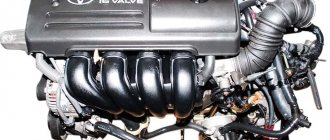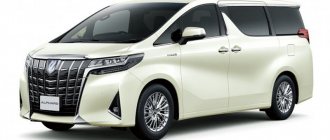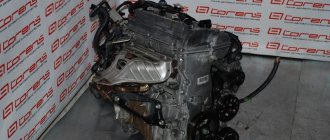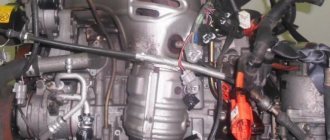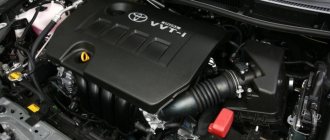Description of the 2ZR-FE engine
2ZR-FE A classic representative of Toyota's inline fours. Production of the engine began in 2007, it was supposed to replace the disliked 1ZZ. The engine is built on the basis of an Aluminum block and an Aluminum cylinder head; the engine architecture can be called long-stroke - the piston stroke is 88.3 mm, and the liner diameter is 80.5 mm. Thanks to the light alloy, the engine weighs only 97 kilograms. Thanks to the long-stroke design, the engine is very economical and also has excellent traction from the lowest revs. The power unit has 2 phase shifters on each camshaft; the gas distribution mechanism is driven by a chain.
The cylinder head is built on the DOHC principle - it has two camshafts and 16 valves - 4 for each cylinder. Hydraulic compensators are used to adjust valve clearances; based on this, we can conclude that the engine will operate adequately only on high-quality oil.
Device
Power unit 2ZR-FE The cylinder block is lined from aluminum alloys.
The sleeves have a ribbed outer side, with which they are fused with the block material for joint strength and improved heat dissipation. Due to the 7 mm wall thickness between the cylinders, overhauls are not possible. The longitudinal axis of the crankshaft is shifted by 8 mm relative to the cylinder axes. This is the so-called desuction, which reduces friction between the piston and liner when maximum pressure is created in the cylinder.
The camshafts are placed in a separate housing mounted on the cylinder head. Valve clearances are adjusted by hydraulic lifters and roller tappets/rockers. The timing drive is a single-row chain (8 mm pitch) with a hydraulic tensioner installed on the outside of the cover.
The valve timing is varied by actuators located on the valve camshafts. Their angles vary between 55° (intake) and 40° (exhaust). The intake valves are continuously adjustable in lift height using a system (Valvematic).
The oil pump operates from the crankshaft using a separate circuit, which is good when starting in winter, but complicates the design. The block is equipped with oil nozzles that cool and lubricate the pistons.
Engine 2ZR-FE removed.
This power plant uses quite a lot of innovations, for example the Valvematic system, which allows you to adjust the valve lift height, and the Dual VVT-i system allows you to change the valve opening phases. A system for changing the length of the intake manifold has also been used. In the coupe, all this allowed us to achieve record low fuel consumption. And also get excellent power characteristics.
In the line of these power units, it is also worth noting the version operating on the Atkinson principle. The principle of this engine is that all strokes (injection, compression, power stroke, exhaust) occur in one revolution of the crankshaft. Power plants of this type have higher efficiency, but with all the advantages, they have very low torque and extremely poor throttle response. This power plant was labeled 2ZR-FXE and was installed on Toyota hybrid cars. It had only 98 horsepower and a huge compression ratio of 13 units.
2ZR-FXE works on the Atkinson principle
A compressor was also installed on the 2ZR-FE from the factory, which made it possible to squeeze 212 horsepower out of the engine and remove as much as 250 HM of torque, without loss of service life.
Advantages and disadvantages
The efficiency of a car with a 2ZR-FE engine is assessed positively. It has low consumption on the highway, although it depends on the outside temperature. Consumption is also affected by the combination with a variator, which is more efficient in this regard, and when paired with an automatic transmission, the engine shows “average” efficiency.
As the speed increases, the camshaft moves in an angular direction relative to the pulley. With specially shaped cams, when the shaft is turned, the intake valves open a little earlier and close later, which increases N and Mcr at high speeds.
The engine has a piston stroke of 88.3 mm, so its Vav = 22 m/s at rated load. Even light pistons do not increase engine life. And the increased waste of oil is also associated with this.
On this model, the timing chain must be replaced after 150 thousand kilometers, it would be better together with other parts, since the old sprockets quickly wear out the new chain. But since the camshaft sprockets are made integral with expensive VVT drives and cannot be replaced individually, changing only the chain does not help much.
The horizontal position of the oil filter is unfortunate, since oil flows from it into the crankcase when the engine is turned off, which increases the time it takes for the oil pressure to rise when starting again.
There are also the following disadvantages:
Maintenance schedule 2ZR-FE
The power plant is quite capricious. To maintain and extend the declared resource of 200,000 kilometers, the power plant must be systematically maintained. Timely replacement of consumables and moderate loads will not only preserve the resource of the unit, but also increase it.
One of the most important consumables is engine oil; the engine is very capricious in terms of lubricant quality, as it is equipped with a Dual VVT-i system and hydraulic compensators; incorrectly selected or low-quality oil can cause problems with phase shifters and hydraulic pushers, and untimely replacement can cause VVT-i valves to stick .
To avoid unpleasant consequences, you should only fill in the oil recommended by the manual - Toyota brand, viscosity 5W-30.
- The timing chain should be checked every 40 thousand kilometers, and it needs to be replaced after 100,000 kilometers; all tensioners and rollers are also changed along with the chain; if this is not done, the chain will begin to rattle after long runs or even jump, jumping the chain threatens the valves meeting and pistons, since the power plant bends the valve;
- The spark plugs need to be monitored once every 20 thousand km. During checks, it is worth cleaning them and adjusting the gap, spark plugs are changed once every 60 thousand kilometers, neglecting this rule can bring disastrous consequences - the ignition coils can fail;
- The oil should be changed every 10 thousand km; if this is not done, then deposits may occur in the VVT-i valves, and the hydraulic compensators will fail quite quickly;
- The condition of drive belts of attachments should be checked every 50 thousand km and replaced if necessary;
- It is recommended to change the coolant every 4 years of vehicle operation; the condition of the pump should be checked every 50 thousand kilometers.
Gas distribution mechanism 2ZR-FE. Driven by chain
Features of operation and main defects
2ZR-FAE under the hood of a car The question of whether this is a good engine or a bad one is initially incorrect.
Judging by quality, reliability and durability, then, of course, old engines are leaders, proven by time and operation. Engines, starting from the third wave of the late 90s (ZZ, AZ, NZ engines), ending with the new generation series (ZR-FE and ZR-FAE), are practically beyond repair, especially their mechanical parts. If you structure the reviews of owners of cars with an installed engine, you can count quite a few defects.
- Oil consumption – increased;
- Combustion chamber – deposition of combustion products;
- VVT drive - knocking sound when starting;
- Pump leakage;
- Vacuum pump – excessive noise when the motor is running;
- Oil is leaking from under the chain cover;
- Forced idle errors;
- Low fuel pressure - as a result, hot starting problems.
It is difficult to calculate the approximate service life of an engine with an accuracy of one year. An installed chain with an advertising slogan - “work throughout the entire service life of the car” does not always live up to reality. It’s not harmful to dream, but it obviously won’t last several hundred thousand km.
Although it is worth noting that the service life of a chain, compared to a belt, is indeed slightly longer, due to the fact that it rarely breaks and does not require scheduled replacement every six months. The only thing that is true is that it, like the belt, needs to be carefully monitored; if the chain breaks, a meeting with the valves is inevitable, and this is a repair that costs a tidy sum.
In principle, it does not require any special intervention, but the chain travel limit is about 150 thousand km. Then it begins to stretch, the hydraulic tensioner loses its position, the chain begins to literally “saw through” the tensioners and dampers, wearing out the shaft rollers, and wear products get into the engine oil. The service life of the engine itself is noticeably reduced.
Review of 2ZR-FE faults
- Binge on oil after a run of 100 thousand kilometers. Most often, the problem lies in the oil seals; replacing them helps eliminate oil consumption in 70% of cases; if this does not help, then perhaps you should change the viscosity and oil manufacturer. In the worst case scenario, a major overhaul of the CPG will be required;
- Engine knocking often appears due to a stretched timing chain or failed hydraulic compensators; if the hydraulic compensators can be repaired by washing, then the timing chain only needs to be replaced; the knocking can also occur due to a worn crankshaft damper pulley. Even if the cylinders are elliptical, the pistons may produce an unpleasant knocking sound during repositioning; this is also accompanied by high oil and fuel consumption; in this case, only a major overhaul of the power plant will help;
- Problems with XX speed are most often caused by clogged injectors or throttle assembly; flushing the fuel system and IAC valve will help cure the problem 100%. Often, unstable idling is caused by jammed valves of the VVT-I system, which is also accompanied by engine dullness and high fuel consumption;
- Since the engine block is made of aluminum, overheating, even the slightest, is very dangerous for it, any excess of the coolant temperature can lead to a change in the geometry of the mating planes of the block and cylinder head, and the power plant thermostat also adds fuel to the fire, which often fails and interferes with the cooling system work, if you have problems with the thermostat, then operating the power plant is highly not recommended.
In general, the 2ZR-FE engine turned out to be quite reliable and with proper handling, systematic maintenance and moderate loads, it will live a long life and fully work out the resource declared by the manufacturer.
Tuning options
Atmospheric tuning of the power plant will not give much effect, because the engineers have squeezed almost all its potential out of the engine. But you can still install worse camshafts, port the cylinder head and increase the compression ratio, install a direct-flow exhaust system, and also adjust the electronic control unit. All this will give an increase of 10-20 horsepower, these upgrades are not worth the money spent, the easiest way is to do a swap and install the 2ZR-FE compressor version.
Turbo kit for 2ZR-FE engine
Ready-made turbo kits based on the Garret GT28 turbine are also available for sale. To install, you will have to do a lot of things with the engine: Install reinforced ShPG elements, lower the compression ratio to 8.5 - 9 units. The turbine comes with pipes, high-performance injectors, blowoffs, an electronic engine control unit, as well as a high-performance fuel pump; you will have to do a fair amount of work with the exhaust manifold and the exhaust system as a whole. This upgrade will add about 100 horsepower to the engine at a pressure of 0.7 bar. It is worth understanding that after installing the turbine, the engine life will suffer.
With proper tuning, the engine can withstand up to 1.2 bar excess.
List of car models in which it was installed
- Toyota Allion - (06.2007 - 03.2010) - sedan, 2nd generation, T260
- Toyota Auris (10.2006 - 09.2009) hatchback, 1st generation, E150
Russia
- Toyota Corolla (03.2016 - present) restyling, sedan, 11th generation, E180
- Toyota Corolla (05.2012 - 07.2016) sedan, 11th generation, E180
USA
- Toyota Corolla (04.2013 - present) sedan, 11th generation, E170
- Toyota Corolla (10.2010 - 09.2013) restyling, sedan, 10th generation, E140
- Toyota Corolla (01.2008 - 09.2010) sedan, 10th generation, E140
- Toyota Corolla Axio (10.2008 - 04.2012) restyling, sedan, 1st generation, E140
- Toyota Corolla Axio (10.2006 - 09.2008) sedan, 1st generation, E140
- Toyota Corolla Fielder (10.2008 - 04.2012) restyling, station wagon, 2nd generation, E140
- Toyota Corolla Fielder (10.2006 - 09.2008) station wagon, 2nd generation, E140
- Toyota Corolla Rumion (10.2007 - 11.2009) hatchback, 1st generation, E150
- Toyota ist (07.2007 - 04.2016) hatchback, 2nd generation, XP110
- Toyota Matrix (02.2008 - 08.2013) hatchback, 2nd generation, E140
- Toyota Premio (06.2007 - 03.2010) sedan, 2nd generation, T260
- Toyota Vitz (01.2017 - present) 2nd restyling, hatchback, 3rd generation
List of modifications 2ZR-FE
- 2ZR-FE - basic version, equipped with a Dual VVT-i system, engine power 128 horsepower.
- 2ZR-FAE - the only difference from the basic version is that the Valvematic valve lift system was used, and the compression ratio was increased to 10.5. The engine develops 143 horsepower.
- 2ZR-FXE power plant operating on the Atkinson principle. Compression ratio 13, power 98 horsepower, was installed only on hybrid versions of cars.
Engine Specifications
| Production | Toyota Motor Manufacturing West Virginia Shimoyama Plant |
| Engine make | Toyota 2ZR |
| Years of manufacture | 2007-present day |
| Cylinder block material | aluminum |
| Supply system | injector |
| Type | in-line |
| Number of cylinders | 4 |
| Valves per cylinder | 4 |
| Piston stroke, mm | 88.3 |
| Cylinder diameter, mm | 80.5 |
| Compression ratio | 10 10.5 13 |
| Engine capacity, cc | 1797 |
| Engine power, hp/rpm | 128/6000 132/6000 136/5200 136/6000 140/6000 144/6400 147/6400 |
| Torque, Nm/rpm | 171/4400 207/4000 172/4400 175/4400 174/4400 176/4400 180/4000 |
| Fuel | 95 |
| Environmental standards | Euro 5 |
| Engine weight, kg | 97 (dry) |
| Fuel consumption, l/100 km (for Corolla E170) - city - highway - mixed. | 8.3 5.3 6.4 |
| Oil consumption, g/1000 km | up to 1000 |
| Engine oil | 0W-20 5W-20 5W-30 10W-30 |
| How much oil is in the engine | 4.2 |
| Oil change carried out, km | 10000 (better 5000) |
| Engine operating temperature, degrees. | — |
| Engine life, thousand km - according to the plant - in practice | n.d. ~250 |
| Tuning - potential - without loss of resource | 250+ n.a. |
Technical characteristics of the compressor version 2ZR-FE
| Engine capacity, cc | 1797 |
| Maximum power, hp | 212 |
| Maximum torque, N*m (kg*m) at rpm. | 250 (26) / 4800 |
| Fuel used | Premium gasoline (AI-98) |
| engine's type | in-line, 4-cylinder, DOHC |
| Add. engine information | electronic fuel injection system |
| Cylinder diameter, mm | 80.5 |
| Maximum power, hp (kW) at rpm | 212 (156) / 6800 |
| Supercharger | Compressor |
| Start-stop system | No |
| Piston stroke, mm | 88.3 |
If you have any questions, leave them in the comments below the article. We or our visitors will be happy to answer them
Toyota engines of NZ and ZR series. Stalwart Privates
We all remember how unpretentious, omnivorous and durable the small Toyota engine of the 80s and 90s was. That is, the one that had a volume of up to 1.6 liters, up to a maximum of 1.8 liters, and was installed on all sorts of Corolla, Carib and similar golf-class hits. “SAE oil” was poured into it, and the filters were forgotten to be changed. And he worked and worked. Other representatives of those lines - for example, the A series - are still in service en masse. What mileage do they have, how many “capitals” have they gone through, but they still serve. But a new century has arrived, and with it a different approach to creating engines. What can they do now - modern compact Toyota fours?
Last of the Normal
“People's Brand” in the small class also sometimes spoiled the consumer with a variety of engine ranges. Although, unlike, say, Nissan, the company has always relied on pragmatism, and not on the desire to surprise with novelty. So, at the end of the last century, Toyota had units that were used mainly on representatives of the B-class (E series). Among them there were installations designed for “wooden” station wagons, and at the same time one turbo engine. At the same time, engines of the Y line were produced - lower-head engines for commercial vehicles, among which there was also a 1.6 liter engine.
E and Y series engines
Let us also recall SZ engines, developed either by Daihatsu or jointly with Daihatsu, and installed primarily on cars of this brand. Well, the main ones for most models were units of the A range, which were produced from the late 70s to the mid-2000s and had carburetor, 20-valve, compressor and turbo versions.
SZ and A
Of course, each of these families had their own characteristics. Some of them were disliked for their supposedly inferior resource compared to others. Others were simply outdated and did not meet the needs in terms of power. But in general, at some point those engines began to be remembered with nostalgia - they say, “they served and didn’t ask for food or drink.”
Narrow range and wide application
Back in the early and even mid-2000s, it was not possible to assess the full scale of the impending disaster due to the lack of any operational experience. However, already at first glance it was clear that the new NZ engines are a slightly different “fruit” than the same A series. The block is already aluminum, the timing drive is chain. On the intake camshaft there is a VVT-i coupling.
The first to appear was the 1.5-litre 1NZ-FXE. It operated on the Atkinson cycle and developed less than 80 hp. and worked as part of a hybrid power plant. In 1997, the Prius became its owner.
The regular 1NZ-FE, as well as the 1.3-liter 2NZ-FE (with the same cylinder diameter of 75 mm, differed only in the piston stroke - 84.7 and 73.5 mm, respectively) appeared in 1999.
The engines had a plastic intake manifold (1NZ-FXE - aluminum) and power in the range of 105–110 and 85–90 hp. At first, they were received by models on the Vitz/Yaris platform - Platz and FunCargo. Later - Corolla and cars built on its basis.
Over time, both units became widespread throughout the entire Toyota B-class family, including the overseas Scion brand. And they were even installed on large Allion/Premio and WiLL VS.
At the same time, the production of 1NZ-FTE began - turbocharged and developing 148 hp. It went to the unknown (“Thai”) sedan Vios, Vitz/Yaris (RS Turbo and T Sport Turbo versions) and Corolla Axio GT.
The last of the line to debut in 2013 was the 1NZ-FXP. In fact, it was the same FXE designed for hybrid powertrain, but with the ability to run on liquefied gas. It was created specifically for JPN Taxi, an analogue of the London cab.
Thus, NZ, although it did not have many modifications in terms of cubic capacity and technology, became the most widely used. For example, it was installed on the Vitz/Yaris 1NZ until recently. And on the Corolla Axio and Fielder, on the spartan Probox station wagon, this engine is still relevant today.
At the same time, it is obvious that these engines did not meet the new requirements - in particular regarding ecology, and specifically in Europe. Therefore, in the early 2000s, the development of a new line of units began, which began to be used in parallel with the En Zetas and replaced the engines of the ZZ and AZ series.
There are many and different units
Structurally, the ZR-series turned out to be similar to the NZ - an aluminum block with an open cooling jacket, a timing chain drive. After all, there is no other way now. Except that there were now two phase shifters. Yes, the block had different cylinder sizes - 80.5x78.5 for a 1.6-liter engine. For larger modifications, the “cubes” were increased by increasing the piston stroke.
The first to be introduced in the fall of 2006 was the 1.8-liter 2ZR-FE (128–138 hp). It was received by Corollas for the domestic market, Allion/Premio, even Yaris T Sport and Lotus Elise, where with a drive supercharger it developed 220 horsepower.
Already at the beginning of next year, the line was supplemented with a 1.6-liter 1ZR-FE (122–124 hp). If 1NZ-FE and 2ZR-FE became widespread in their homeland and everywhere else, this engine was offered exclusively on export Corolla and Auris. Moreover, with an emphasis on Europe, including Russia, and individual Asian countries.
In 2007, another unit debuted - the 2.0-liter 3ZR-FE (140–153 hp). It was aimed at the Noah/Voxy “buses”, then at the Avensis, RAV4, and the same Corolla for foreign markets.
A year later, Toyota began introducing the next generation of units under the letters FAE - 1ZR (132 hp), 2ZR (139–148 hp) and 3ZR (152–158 hp).
It is clear that the volume was similar, and so were the main design features. FAE differed from FE by the presence of the Valvematic system. That is, if there are two phase shifters at the intake valves, it can be used to regulate the lift height and opening duration.
In addition, Valvematic made it possible to eliminate the need for a throttle valve, entrusting the admission of air into the cylinders entirely to the valves. Structurally, it is arranged as follows: there is an additional lever between the valve rocker arm and the camshaft. It has its own eccentric shaft, which is controlled by a controller and, in fact, provides adjustment of the lift height and duration of valve opening. Moreover, stepless and constant. The video shows how it works:
The FAE modification gradually began to supplant the regular Zeta Eras on all fronts. However, an exception was made for the Russian market. For example, the Auris hatchback we sold could have both versions of the engine.
But Corolla, as a more democratic model, for the Russian Federation was and is still equipped with the usual FE.
Toyota took into account the characteristics of other markets. So, for some Asian countries they released 1ZR-FBE (125 hp), which had the same Valvematic and was capable of running on ethanol. The 140-horsepower 2ZR-FBE was also designed for Asia. But it is installed there, including on the CH-R and Corolla Cross crossovers.
And 3ZR-FBE was used on Brazilian Corollas. For the Chinese market, the above installations were transformed into a 1.6-liter 4ZR-FE, a 1.8-liter 7ZR-FE and a 2.0-liter 6ZR-FE, which apparently differ only in software.
Finally, back in 2009, the 2ZR-FXE was introduced for hybrid powertrain service. Atkinson cycle operation, no Valvematic, phase control only at the intake and output of only 95–98 hp. The loss of power was traditionally compensated by an electric motor. The first to try on the 2ZR-FXE was the Prius in the ZVW30 body. Then the engine was installed on many hybrids: Corolla, CH-R, Voxy, Lexus CT200h, etc.
Like simple FE, hybrid modifications also had Chinese “clones”: 5ZR-FXE (1.8 l) and 8ZR-FXE (the same 1800 “cubes”). They also released a copy of the 2.0-liter 3ZR-FAE - 6ZR-FAE. Thus, in the B-, C- and D-class, including crossovers, “Z Eras” have become and remain the main engines. So we will have to use them for a long time. And En Zetas are not going to retire. Not even because the domestic Japanese market has not yet abandoned them (and cars from there are still coming to us) - both 10- and 20-year-old Corollas continue to be sold and bought.
Not everything is scary that is disposable
Soon after the appearance of En Zetas, it became clear that they should be treated differently from their predecessors. And update the oil more often, choosing at least not the most outright counterfeit, for which the thin piston rings and VVT-i clutch will thank you. And don’t forget to change the spark plugs, thereby increasing the life of the individual ignition coils. And keep an eye on the “eternal” chain. On the other hand, by the 2010s, the culture of exploitation was no longer “Soviet.” And it turned out that NZ motors are not the worst thing you have to deal with.
Roman Gyarvi
Private master
— If you change the oil on time, you can hope that it will start to burn up only closer to 200,000 km. And the resource in this case can reach up to 300,000 km. At least we opened an engine with similar mileage. It was running on gas and the valve burned out. However, the hon remained. Therefore, although the rings were changed as a preventive measure, they were installed in the nominal size.
However, the VVT-i phase shifter will be the first to indicate poor oil quality. It essentially works like a centrifuge, collecting all deposits with old or fake oil. The control hydraulic valve also prevents contamination.
If the clutch stops working, the following symptoms may appear: popping in the manifold, lack of traction, fuel consumption will increase. Many people blame spark plugs, coils, clogged filters. But the reason is precisely that NZ stopped controlling the valve timing.
Until 2005, the valves on En Zetas were adjusted with washers. However, this was not required throughout the engine's life. In 2005, the engines were modernized and hydraulic clearance compensators appeared. Their resource is also directly related to the condition of the oil.
At the timing chain - of course. Therefore, there is a certain difference in the resource that we observed. They can travel 150,000 km, and even 200,000 km. But they often stretch out and jump at a little over a hundred.
Basically, En Zetas do not “capitalize” - they exchange them for contract ones. Now they cost about 45,000 rubles. The only problem is that in our region 1NZ is in great demand - they are installed in homemade “quads” on low-pressure pneumatics.
“Z Eras” came to us at a time when we already had normal oils with filters, and an understanding that cars needed to be serviced. Accordingly, they did not cause such a shock as NZ. We are better known for the 1ZR-FE - naturally, from the Corolla. But the services know both 2ZR and 3ZR. Including FAE versions with Valvematic, which for some time came to us officially and came on the “right-hand drive”. So there is service experience. Let's hear a couple of opinions. The first is from a person who repairs cars and has personally operated several left-hand drive Corollas in the E150 body.
— From my own experience, I know that it is better to pour oil with a viscosity of 5W-30 or 5W-40 into 1ZR-FE. With “liquid” oil 0W-20, after a mileage of 50,000 km, there were local overheating and pistons sticking to the cylinder walls. But subject to timely replacement, this “four” is capable of traveling up to 300,000 km. True, at about 60,000–70,000 km the “oil burn” begins. It can reach up to 1–1.5 l/5000 km. And remain within these limits almost until the end of the engine’s life.
By the way, you need to keep an eye on the oil not only in terms of its condition. Its pressure sensor, located between the engine and the engine shield, tends to leak. Little by little, but absolutely unnoticed by the owner. But there is no pressure indicator in the instrument cluster - the level can be monitored.
Second opinion - from a serviceman from a dealership:
— I can’t say anything about piston sticking due to 0W-20 oil - this has never happened in my practice. In terms of oil consumption due to waste, a similar feature was noticed: indeed, somewhere under 100,000 km, the Zeta Era begins to consume oil. At the same time, some of the cars are still under warranty, and, as you know, Toyota’s maintenance frequency is once every 10,000 km. So we can’t talk about old oil that has passed over. However, the “oil guzzler” is not particularly large - a liter and a half, but not for 5000, but for 7500 km. And it doesn't increase with mileage.
The resource of the cylinder-piston group is actually in the region of 300,000 km. At the same time, until the very end there are no bullies. Moreover, from the ingress of ceramic dust from melted catalysts into the cylinders. By the way, they are quite tenacious.
Of course, there are no official repair sizes, and I personally have never done a major restoration. However, I know they do. The resource of the timing chain drive is also impressive - from 200,000 km and above.
The hydraulic compensators work, the phase shifters do not rattle, and I don’t remember any failures. ACIS (Acoustic Control Induction System), a system for changing the geometry of the intake tract, does not cause any trouble. As well as an electric pump and EGR with intercooler on the 2ZR-FXE.
But the regular pump on other engines leaks. Previously, Toyota prescribed changing the gasket if there were antifreeze stains around. Later - only if a wet spot forms on the control piece of paper. And the pump itself has a resource of about 50,000–70,000 km.
Oil leaks also happen. Through the pressure sensor mentioned above and the timing chain tensioner gasket.
A leak in the area of the hydraulic tensioner and a camshaft bed separate from the “head” of the block, from under the gasket there are no leaks
This is not widespread. But along with the consumption of oil due to waste, it can lead to a sad result. On the same Corolla there is no pressure light in the instrument cluster. Only on the on-board computer screen should the low oil level alarm appear. And yet, more than once I had to deal with situations when there was no level at all, and the machine did not report this in any way. So it’s better to assess the presence of oil the old fashioned way - by inspecting the dipstick.
Sometimes the bypass clutch on the generator pulley fails. The most unpleasant and costly problem of all ZR-FEs is burnout of the cylinder head gasket. Sometimes this happens between the second and third cylinders. But more often - between the first and second. Apparently, some local overheating occurs in this place. In this case, oil does not enter the cooling system, and antifreeze does not enter the lubrication system. Only the compression “walks” between the cylinders - the engine troits, the car does not pull. In most cases there is no need to level the mating surfaces. Although this also happens.
During low-temperature starts, if the Zeta Era is flooded, it is extremely difficult to start it. It is necessary to warm it up, be sure to unscrew the spark plugs and blow through the cylinders. Sometimes, even in a warm box without blowing, the ZRs will not start.
The FAE line with Valvematic has its own characteristic malfunction. The controller that controls the eccentric shaft fails.
This can happen up to 100,000 km, at 150,000 and after. That is, I don’t see any connection to mileage. And, perhaps, to the operating conditions too. The controller contains sensors, a servo drive and a control unit. Apparently, the last one refuses. That is, the problem is electronic in nature. And massively - in my opinion, almost all cars with ZR-FAE went through it. Sometimes the car only loses dynamics as fuel consumption increases. In other cases, the control system goes into emergency mode. Allegedly, somewhere (I heard that in Novosibirsk) the controllers are being restored, but I have not come across such ones. We changed it - the price is from 60,000 to 70,000 rubles. It's good that at least it doesn't bend the valves.
If it were not for this typical malfunction and the cost of fixing it, ZR engines could be considered very reliable by modern standards. Simple FEs, in general, are just that. Even burnout of the cylinder head gasket is far from a widespread phenomenon; rather, it indicates operational problems with the cooling system (the coolant needs to be changed, the radiator needs to be cleaned). Otherwise, they are very good, durable engines.

